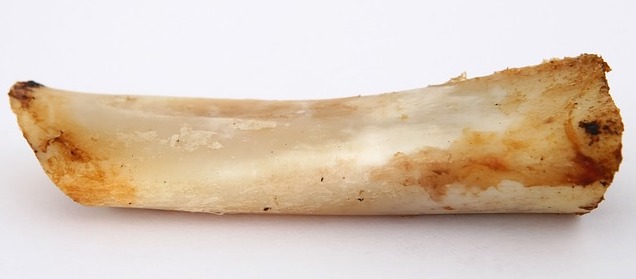One Of These Bones Is Not Like The Other
But note that I said that dogs can digest “some” bones. And that’s because not all bones are created equally. Some bones tend to crumble when chewed, while others fracture, often yielding razor-sharp edges that can damage your dog’s digestive system.
Many of the bones found in birds, for example, are very thin, full of air sacs and easy to break. This helps them to keep their weight low and improve the lift-to-body-weight ratio. By contrast, the bones of a cows and pigs are much more massive so they can support the bulk of such large animals, who rarely fly.

Even among the bones of a single species, there is great variation. Some bones are extraordinarily dense, while others are filled with hollows and weigh practically nothing. Some have a central void that contains nutrient-rich marrow, while others carry their marrow in flatter, thinner pockets. Still other bones have no marrow at all.
A couple of factors determine how well your dog will digest a given bone.
Thousands of dog owners give their pup bones each year. Most probably digest the bones without problem. But this does not mean that bad things don’t happen, because they are far too common.
Starting from the point of entry, let’s examine some of the problems that can occur after offering your dog a bone:
How Bone Digestion Works in Dogs
Dogs share a common ancestor with wolves, and in the wild, their ancestors needed to get as much nutrition as possible from their meals. That means they might have eaten smaller bones whole and chewing bigger bones open to get anything they could out of it. Today, dog bones are common treats, and many dogs will be interested in bones they find around your home or yard.
If your dog does swallow a bone, stomach enzymes start breaking it down right away. Most of the time, it passes through the system fully within about eight to twelve hours. However, larger bones might take longer to break down. If you’re worried about your dog eating a bone that it shouldn’t have, it’s safest to watch for two days.
If your dog does pass a bone, you might see white, chalky stool, or else stool that becomes white and chalky after it dries. This is from all the extra calcium in the bone.
When your dog chews on a bone, the first danger you need to worry about is choking. Most dogs are smart enough not to swallow too big of a bone, but you should still supervise your dog around bones that might be a choking hazard.
A second, scarier danger is damage to your dog’s stomach or intestines. This is more dangerous in cooked bones and hollow bones from birds because they are more likely to break into sharp pieces. Don’t feed your dog cooked chicken bones. These bones can cause tearing or blockages in your dog’s stomach or intestines. In some cases, a large chunk of bones can also cause a blockage in your dog’s intestines.
What happens to bones in a dog’s stomach?
They can also become lodged in the intestines (particularly the small intestines), leading to a painful and dangerous obstruction. Any intact bones (or fragments thereof) can cause lacerations and trauma to your dog’s anus as she tries to pass them.
Will dog stomach acid dissolve bone?
A dog’s stomach acid will typically dissolve a bone before the bone can cause a blockage. The pH level in your dog’s stomach is what determines how fast a bone will dissolve. The lower the pH in the dog’s stomach, the faster the stomach enzymes will break down bones.
We have associated bones with dogs from our earliest childhood experiences—from every cartoon we watched, to the pictures we drew in school, to the dog-art currently hanging on our wall—when there’s a dog, a bone is never far behind.
We know dogs enjoy chewing on bones, but are they safe for consumption? This article will talk about bones, why dogs like them, what the dangers are, and if a dog’s stomach acid can actually dissolve bones or if the fragments will end up causing a blockage.